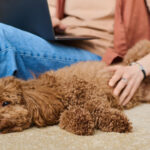Why Do Dogs Flap Their Ears In The Morning
The Mysterious Morning Flapping of Dogs’ Ears: What’s Behind this Canine Habit?
Dogs are fascinating creatures, full of quirks and mysteries that keep us curious and entertained. One such habit that many dog owners have noticed is the flapping of their dogs’ ears in the morning, often accompanied by yawning, stretching, and wagging. While this behavior may seem random or insignificant, it actually reveals some interesting insights into the nature and needs of dogs. In this article, we will explore the reasons why dogs flap their ears in the morning, what it means for their health and happiness, and how we can respond to this behavior in a positive way.
Understanding the Anatomy and Function of Dog Ears
Before we dive into the reasons why dogs flap their ears in the morning, let’s take a closer look at what makes dog ears so special and versatile. Unlike human ears, which are mostly fixed and external, dog ears are mobile and sensitive to sounds, movements, and emotions. This is due to several features of canine ear anatomy:
– Ear muscles: Dogs have about 18 ear muscles (compared to our 6), which allow them to move their ears independently or together, up or down, forward or backward. These muscles are controlled by nerves that respond to various stimuli, such as sound waves, air pressure changes, touch sensations, or emotional signals.
– Ear shapes: Dogs come in various breeds and sizes that have different shapes of ears. Some dogs have floppy ears that hang down loosely (such as Basset Hounds), while others have erect or semi-erect ears that stand up straight (such as German Shepherds). The shape of a dog’s ears can affect how they hear and process sounds, as well as how they express themselves through body language.
– Ear functions: Dogs use their ears not only for hearing but also for communicating with humans and other dogs. When a dog is happy, excited, or curious, they may raise their ears, wag their tail, and approach the source of interest. When a dog is scared, anxious, or in pain, they may lower their ears, tuck their tail between their legs, and avoid eye contact or touch.
Now that we have some basic knowledge about dog ears, let’s move on to the main topic of this article: why do dogs flap their ears in the morning?
Theories and Explanations for Morning Flapping
There are several theories and explanations for why dogs flap their ears in the morning, based on observations and studies of canine behavior. Here are some of the most plausible ones:
– Stretching: Like humans, dogs need to stretch their muscles after a long rest (such as sleeping through the night). One way to do that is by extending their limbs and torso, yawning, and flapping their ears. This can help increase blood flow, oxygenation, and flexibility throughout the body.
– Waking up: Dogs are diurnal animals, which means they are more active during the day than at night. When they wake up in the morning (usually around the same time as their owners), they may feel refreshed and eager to start a new day. Flapping their ears could be a sign of excitement or anticipation for what’s to come.
– Shaking off: Dogs also have a natural instinct to shake off any dirt, debris, or excess moisture from their fur and skin. By shaking their heads or bodies vigorously, they can dislodge any particles that might irritate them or cause infections. Flapping their ears could be part of this shaking-off behavior.
– Cooling down: Dogs don’t sweat like humans do (except through their paw pads), so they need other ways to regulate their body temperature. One way is by panting (breathing rapidly with an open mouth), which can help release heat and moisture from their lungs and tongue. Another way is by flapping their ears, which can increase air circulation and cooling around the head and neck.
While these theories are not mutually exclusive, they offer some insights into why dogs flap their ears in the morning. However, there may be other factors that influence this behavior, such as the breed, age, health, or personality of each dog. Some dogs may flap their ears more than others, or in different contexts (such as when they hear a loud noise or smell a familiar scent). Therefore, it’s important to observe your own dog’s behavior closely and consult with a veterinarian or trainer if you have any concerns or questions.
Responding to Morning Flapping in a Positive Way
Now that we know more about why dogs flap their ears in the morning, let’s discuss how we can respond to this behavior in a positive way. Here are some tips:
– Acknowledge: When you see your dog flapping their ears in the morning, acknowledge them with a smile, a pat on the head, or a gentle word of praise. This will show them that you appreciate their natural behavior and that you’re happy to see them.
– Engage: If your dog seems eager to interact with you after flapping their ears (such as by wagging their tail or licking your face), take some time to engage with them. Play fetch, cuddle on the couch, go for a walk together ¨C whatever activity you both enjoy and benefit from.
– Provide: Make sure your dog has access to clean water, nutritious food, comfortable bedding, and stimulating toys throughout the day. This will help them maintain their health and happiness and reduce any stress or boredom that may lead to unwanted behavior.
– Train: If your dog displays any problematic behavior (such as excessive barking, chewing, digging, or jumping), consider



